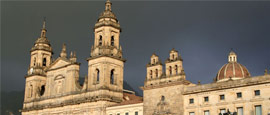Bogotá History
Bogotá's origins can be traced back to 1538 when Gonzalo Jimenez de Quesada decided it was a good location to found a settlement for his fellow Spaniards. Originally called Santa Fe, it was actually built on the site of Teusaquillo, a small indigenous settlement in the area that was predominantly inhabited by Chibcha speaking people.
The city steadily grew and soon became the capital of the New Kingdom of Granada and the Royal Court was established there in 1550. By the beginning of the 19th century, its population had reached 30,000 and its cultural, academic and artistic offerings showed all the characteristics of a true national capital, with three universities, a large number of monasteries, convents and schools, as well as numerous collections of paintings, carvings and sculptures.
A new chapter in the town's life began on 20 July 1810 when the independence movement started. A charismatic Simon Bolivar (still very much in the minds and hearts of the today's Latin America) was elected president of the new republic which desperately tried to run away from the despotic, greedy and parasitic rule of the Spanish court. In 1819 the city changed its name to Bogotá.
The city has since developed its infrastructure and established itself as the country's main urban centre. Interestingly, the 20th century remained a fairly dictator-free period, something that cannot be said for the rest of continent.
Bogotá earned a bad reputation, however, through its notoriously poor record for safety, mainly to do with the narco-mafia and organised crime that plagued the city in the 1980s and early 1990s.
On 6 November 1985, the city was rocked when the Palace of Justice was besieged by 35 guerrillas from the 19th of April Movement who demanded that President Belisario Betancur “stand trial”. They held some 300 lawyers, judges, and Supreme Court magistrates hostage. A day later, 115 people were dead.
The city’s stability improved substantially in the 2000s after the former NYC mayor Rudolph Giuliani's crime fighting policies were implemented by Colombia's 31st president Alvaro Uribe.
Did you know?
• Began in 1998, the cycle lane network in Bogotá is now the most extensive in South America.
• In 2013, Jhonathan Florez broke four wingsuit world records when he jumped from a helicopter over Monserrate in Bogotá. They included the longest duration, the highest jump and the greatest horizontal distance ever travelled.
• The Bavaria Brewery, which still exists today, started its operations in Bogotá in 1889.
Do you have any Feedback about this page?
© 2025 Columbus Travel Media Ltd. All rights reserved. No part of this site may be reproduced without our written permission, click here for information on Columbus Content Solutions.




 You know where
You know where